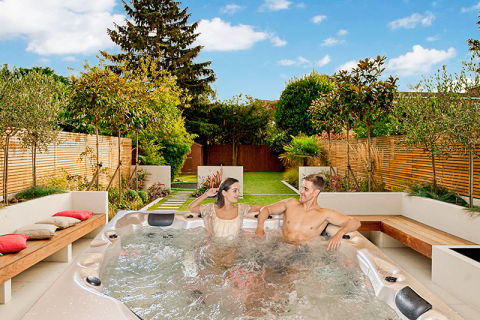
- Home
- >
News
The chemical addition sequence should strictly adhere to these principles: 1. Adjust alkalinity first 2. Adjust pH second 3. Adjust hardness 4. Remove metals 5. Add stabilizer 6. Add disinfectant 7. Perform maintenance by shock treatment
The fundamental reason why chlorine and hydrochloric acid cannot be mixed: a violent chemical reaction. Although chlorine and hydrochloric acid both play important roles in swim and spa pool water treatment, they should never be mixed directly, especially in their undiluted, concentrated form, which is extremely dangerous.
The disinfecting efficiency of chlorine is closely related to the pH of the water. When the pH of a swim spa tub is low (<7.0), chlorine is more likely to form HOCl, but it also reacts more readily with other ions in the water. In an acidic environment, metal oxidation is more intense, resulting in more pronounced yellowing.
One of the core components of a swim spa jacuzzi tub is the pump, responsible for moving water, circulating it within the tub, and driving the massage jets. A water pump generates some vibration during operation. If this vibration is not effectively absorbed or secured, it may cause noise.
In some quiet neighborhoods, the noise of an outdoor swim spa tub operating in the evening or early morning may cause discomfort to nearby residents, especially if the noise persists for an extended period. If the noise is loud or occurs at night, it may lead to complaints from neighbors who may be disturbed by the noise.
Technically, swim spa tubs can be installed underground, but only if they meet a series of strict design, construction, and maintenance requirements. This installation method can improve overall aesthetics, spatial integration, and safety (especially for homes with children or elderly residents), but it also presents more engineering challenges.
Substances that should not be mixed with chlorine in swim spas include: 1. Acidic chemicals (e.g., dry acid, hydrochloric acid) 2. Ammonia-containing compounds (e.g., ammonia, certain detergents) 3. Other oxidizing or reducing agents (e.g., hydrogen peroxide, chlorine dioxide) 4. Grease (e.g., skincare, lotion, hairspray residue) 5. Dirt and high concentrations of organic matter (e.g., urine, sweat, cosmetic residue) 6. Metal ions (e.g., iron, copper, manganese) 7. Fragrance or coloring additives
Showering before and after using a swim spa tub is essential. The primary purpose of showering before use is to cleanse the skin. Showering immediately after use effectively removes any residual chemicals on the skin's surface, reducing irritation and allergic reactions.
A small rectangular swim spa tub is one of the most common sizes. For a bathtub approximately 2 meters in length, 1.5 meters in width, and 0.8 meters in depth, the required installation space is approximately: 2.6 meters x 2 meters, approximately 5 square meters. Considering the layout of the equipment and plumbing, the ideal installation space is 3 meters x 2.5 meters, approximately 7.5 square meters.
• Monthly Cleaning: For frequently used swim spa jacuzzis, a thorough monthly cleaning of the filtration system is essential. • Seasonal Cleaning: Even if usage is infrequent, it's best to thoroughly inspect and clean the filter quarterly to ensure optimal water quality.
The water in a swim spa jacuzzi is different from ordinary bathtub water. It is recycled and typically maintained at a relatively high temperature (approximately 37°C to 40°C) for extended periods of time. If the water quality is not properly managed, the water in a swim spa jacuzzi can become quite dirty. Major contaminants include: 1. Bacteria and viruses 2. Human waste 3. Chemical contaminants
Before installing an outdoor swim spa jacuzzi, you must first determine a suitable location. Outdoor swim spa jacuzzis are large in size and therefore require a suitable space. Selecting an adequate space is one of the most important preparatory steps for installation.












